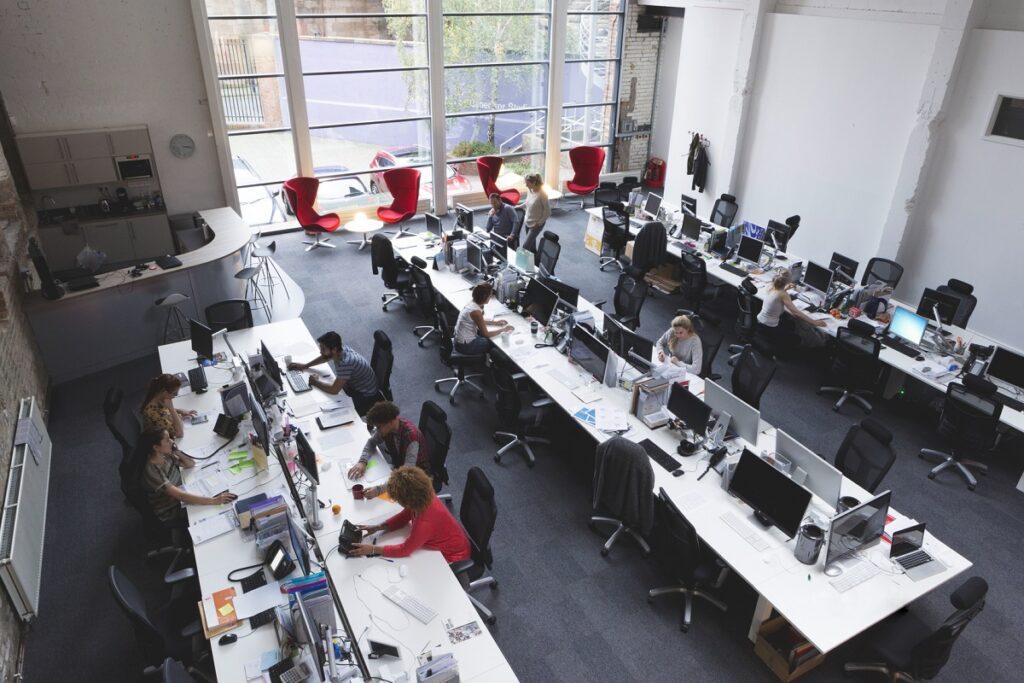Multiple firms, entrepreneurs and freelancers working in the same office space, an arrangement known as coworking, is one of the most recent trends to sweep across the world of work.
Firms of all sizes, the length and breadth of the country, are beginning to supplement their traditional, static offices with a range of flexible and shared office concepts that include coworking.
Coworking’s remarkable growth suggests that it is here to stay. We estimate the size of the global coworking market to be in the region of circa $210m a month, and the number of individuals using coworking spaces is predicted to reach 1 million by 2018.[1]
Flexibility
The appeal of coworking is not confined to start-ups and smaller firms. Large corporates like Orange, IBM, Coca Cola and Phillips, alongside a number of smaller firms and start-ups, have all embraced coworking, incorporating the arrangement into their workplace settings.
Coworking injects greater diversity and innovation into the workplace
And here lies one of coworking’s main strengths from an employment perspective. With multiple firms, of different sizes and from across different sectors, working in the same space, coworking injects greater diversity and innovation into the workplace. In such a space, an established and experienced corporate professional can find him or herself sat next to a younger entrepreneur. Such a situation allows for the flow of knowledge, ideas and experience. Put simply, both big firms and start-ups get exposure to new ideas, new ways of working and a new network of contacts.
Moreover, coworking can also allow HR departments to accommodate sudden or unexpected changes in staffing levels, whilst companies with multiple coworking spaces can offer their staff a choice of work places, potentially energising staff by breaking monotonous morning commutes.
Data issues
Coworking does present some challenges for HR departments to grapple with. Having multiple firms inhabiting one room, for instance, could lead to the loss of sensitive information, especially as employees are often required to bring in portable electronic devices from home. Moreover, whilst coworking aids the flow of ideas and knowledge, there is a risk of sensitive information being overheard by employees of a different firm.
HR teams can help ensure that coworking is utilised effectively
Neither of these challenges need prove insurmountable and, with careful planning, HR teams can help ensure that coworking is utilised effectively. For a start, issues surrounding data loss are not uncommon, and most businesses where employees already work flexibly and/or remotely will already have in place programmes, policies and procedures to adequately manage the challenges of employees working from locations other than the office.
As a prerequisite for using a coworking space, then, firms should seek to devise and deploy a robust cyber security policy, such as the provision of separate servers or private Wi-Fi networks. The procedural elements within the policy must then continue to evolve alongside the on the ground reality of coworking. As coworking arrangements develop, and the way the employees and company work changes, so too the cybersecurity arrangements must adapt.
Coworking may also evolve to reflect changing user requirements, including the provision of private rooms to allow sensitive conversations to take place away from other occupants of the coworking space.
Coworking models
Our recent report, ‘A New Era of Coworking’, showed four different models that businesses can adopt in order to enjoy the full benefits of coworking, and these are:
- Internal collaboration: the creation of an innovation hub exclusively for employees within a company’s own office. This helps to drive internal collaboration and signal to the new generation that the company is open to the new ways of working. It is worth noting that this model does create limited exposure to external collaboration though, but, as a result, it does limit the HR issues that may arise.
- Coworking memberships model: this sees companies and individuals having memberships to access other coworking spaces. This can provide a greater variety of workplaces for employees and allow companies to accommodate fluctuations in workforce numbers. External memberships also provide a range of work settings and help companies to tap into new networks and keep a pulse on market developments without any costly modifications to their existing buildings and potential disruption to the wider company culture. However, HR teams should be aware that issues like security concerns and proximity to competitors will need to be carefully managed.
- External coworking space: a collaboration space for employees shared with external organisations/individuals in an external coworking environment. Here coworkers can find themselves surrounded by different types of businesses, allowing for the free exchange of knowledge and ideas. Given the potential here for data loss and breaches of confidentiality/security, any employees using such a space should be fully briefed on procedures, policies and tools to prevent this. Employees’ proximity to competition and extended absence from the office should also be considered by the HR teams when implementing the model.
- The internal coworking space: this sees firms open up their offices to external firms or entrepreneurs. Not only does this help engender the climate of collaboration, but gives access to talent, knowledge sharing and the opportunity for innovation as well as more control over IT security. The same sorts of privacy challenges also apply – but potentially in a reduced form as the company has more control over its own space. It is also worth noting that this model is where a clash of cultures between host and coworkers could be most keenly felt, so HR functions must be cognisant of possible challenges here.
With careful planning, and a careful consideration of the available coworking options and the attendant challenges, there is no reason why coworking can’t be utilised effectively by businesses of all shapes and sizes.
[1] JLL, ‘A New Era of Coworking’, (JLL, 2016) p.2 and Smallbizlabs, 2014







One Response
I think a lot of people think
I think a lot of people think HR is easy! Ha!